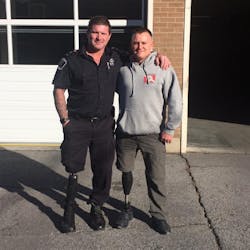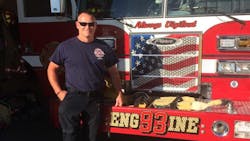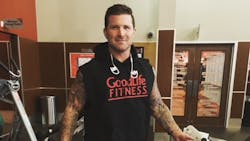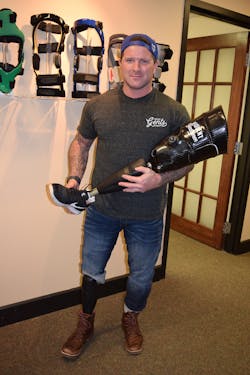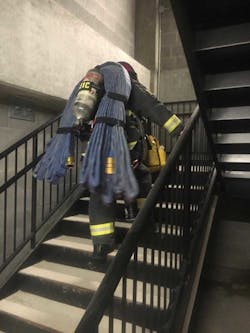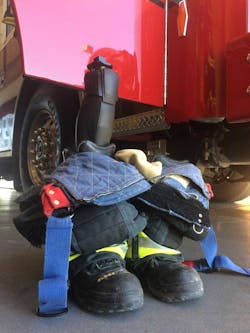Amputee Firefighters Cross Borders to Form Bond
Brandon Anderson and Mike Laughlin took similar journeys into their firefighting careers.
Both wanted to serve their communities and help others, and both enjoyed the everyday challenges of the fire service.
These similarities between driven personalities form lasting bonds among firefighters across the country and around the world, but the connection between Anderson and Laughlin runs far deeper.
Not only do they both love being firefighters, but their mutual love of motorcycles probably would have made them instant friends under different circumstances.
In an unfortunate turn for both, it was that love of being out on the road that ultimately delivered the greatest personal challenge they have ever faced, but also created a cross-border friendship that will most likely last a lifetime.
A scenic ride changes everything
Brandon Anderson had been a firefighter in Fishers, IN, for over a dozen years when he began his day on Aug. 12, 2016, much like any other.
Hoping to enjoy some time off from the job with a group of childhood friends, Anderson set out on his motorcycle en route to a weekend getaway at Lake Cumberland.
"We were trying to just take advantage of the time off and have a nice scenic drive about five hours away," Anderson said in a recent interview with Firehouse.com.
After riding for only about an hour, a truck driver made a sudden lane change without signaling, and Anderson could not avoid the collision.
The veteran firefighter was thrown from his bike, which then landed on top of him and badly mangled his right leg.
"I tried to get out (from under the bike) but my friend who was riding with me who is a police officer in Indianapolis, he circled around and stopped me from moving because he could see the damage already," Anderson said.
While Anderson was still a ways away from knowing the full extent of the damage to his leg, another thing he had no way of knowing at the time was that only two months earlier something eerily similar had happened over 600 miles away to a brother he had never met.
Mike Laughlin calls himself a "typical Canadian" because of his younger days playing junior hockey, and he's always led an active lifestyle that included taking his Harley-Davidson out for a ride on mild summer days.
That's how the Kingston, Ontario, firefighter remembers the early part of June 6, 2016, when he set out for a ride through the countryside.
"It was just a normal day," Laughlin told Firehouse.com. "Nice weather and I was out cruising, not speeding or anything like that."
During his ride and seemingly out of nowhere, a deer ran into the road, and Laughlin didn't see it right away. The animal grazed him and sent his bike wobbling, but he was able to regain control.
Once he straightened out, however, he looked up and saw he was coming to a sharp curve, which he tried to take but couldn't. The bike flew out from beneath him and he went sliding into a ditch with the vehicle landing on top of him.
"When I went into the ditch, there was a large rock and I saw my leg hit it and it just tore my leg off right at the knee," Laughlin said. "All I could think was, 'Oh my God, I just killed myself.'"
Assessing the damage
While Anderson was still pinned beneath his motorcycle, he and his friend knew they had little time to spare because of how badly the firefighter was bleeding. It turns out that the multiple breaks in his leg had severed an artery.
"I remember him looking at me and saying, 'This is more your area of expertise than it is mine, but we have to do something. Your leg's in bad shape.' At that point I looked down and realized what he was talking about. I was bleeding out pretty good," Anderson said.
Anderson started to remove his belt to fashion a tourniquet and slow the bleeding, but his friend had luckily taken a small trauma kit from his police cruiser that morning that contained a field tourniquet. The firefighter credits his friend with helping to save his life.
"By that time, a few more people had stopped and they were able to extricate me from under the bike," Anderson said.
Emergency crews arrived on scene shortly thereafter, and although Anderson asked to be taken to Indianapolis, he was instead rushed to University of Louisville Hospital, which was only ten minutes away via helicopter but a two-hour drive away for his wife Nesha.
"I told her that I was OK and that I had a broken leg, kind of knowing all the while that it was much worse than a broken leg," Anderson said. "I wanted to try to ease her mind having to make that drive."
"I felt like she had the worse end of the deal that day, but she made it down just a few minutes before they took me back to surgery for the first time."
As harrowing an ordeal as Anderson went through before arriving at the hospital, Laughlin's situation two months prior was a bit more precarious because he was riding alone in a secluded area and had gone into a ditch.
Laughlin says he heard a car go by shortly after the wreck, but the driver couldn't see him or hear him yelling for help. It was then that he decided he was his best hope, so he pulled his cell phone from a pocket—which luckily hadn't broken—and called his own fire department for help. He also used his belt as a tourniquet.
"I called our fire dispatch and it was the private line," Laughlin said with a chuckle, "so she answered and said, 'Hey, Mike, how's it going?'"
With help on the way, Laughlin was able to push the bike off and tossed his helmet and some broken bike parts that were within reach up onto the road. Eventually, several drivers realized something was amiss and stopped to try and help. A man also gave him a length of rope to fashion a stronger tourniquet.
"There was a little old lady who stopped, and she came down into the ditch and she basically just put her arms around me and just told me it was going to be OK," Laughlin said. "It was really strange because it was a pretty gory scene, and this old lady, it didn't bother her one bit."
"My mom actually looked her up so she could thank her."
Once he was packaged up in the ambulance, Laughlin says he felt every bump during the 15-minute ride to the hospital. In addition to the injuries to his leg, which he says "was hanging on by just a bit of skin," he would later learn that he also had crushed vertebrae in both his back and neck.
Surgeries and hard decisions
The parallels between Anderson's and Laughlin's stories continued after they were stabilized, with the only difference being that Laughlin was placed in a coma because of the extreme pain he was in from the neck and back injuries.
"I was so messed up that they induced a coma for eight days," Laughlin said. "I went through three surgeries during the coma. They fused two eight-inch rods along my spine and then they did a whole bunch of work to my leg."
Anderson's initial surgery resulted in his leg being re-attached and blood flow being restored, which gave him early hope that he could recover, but an infection led to subsequent surgeries and the removal of more and more leg tissue.
"There was a point where my wife and my family and friends and the guys here at the firehouse that had been coming down on a daily basis... I think they all knew it was going to happen before I did," Anderson said of losing his leg.
"I wasn't quite at that point yet to give up. I was of the mindset of 'I can beat this.'
The same exact scenario confronted Laughlin when he awoke from the coma. An infection had set in after his leg was re-attached, and the process of removing the infected tissue made it less and less likely he would ever recover even the most basic use of his leg.
"The end result of not amputating would have just been a club foot, and I never would have been a firefighter again. I know that," Laughlin said.
With not only their quality of life hanging in the balance but also any chances they had of returning to their careers, both firefighters made the difficult decision to have their right legs amputated above the knee.
"I was very concerned at this stage of the game because of the profession I was in," Anderson said. "Was it possible for me to go back to work? Is there going to be a way for me to get back and provide for my family?"
"And by going back to work, it meant going back to everything I did before."
Learning everything all over again
Anderson and Laughlin wasted little time in deciding that they would return to their jobs as full-time firefighters.
"I shed a couple of tears and it was shocking," Laughlin said, "but only a few hours after the surgery, I was sitting with my dad on an iPad looking at different prosthetics to find which one was going to let me be a firefighter again. I didn't take much time to grieve over it."
Anderson also refused to feel sorry for himself and sought out advice on how he could not only get back to everyday life but also get back to everyday firefighting.
"It was going to be a new challenge for me," Anderson said. "Not only to get back to where I could function in my job but to also just function on a quality-of-life level with my family."
"I got into this job to take care of people and to make somebody's bad day a little bit better, and here I found all of a sudden myself on the flip side of that. That was one of the struggles for me, more so than the physical aspect."
Both firefighters eventually discovered the same advanced prosthetic leg that would allow them to function in their careers—the Ottobock X3. First designed for the military, the leg is water- and corrosive-proof, and has a microprocessor that helps them push off during certain tasks such as taking stairs.
"We both researched it and it's the best leg you can get," Laughlin said. "It does make a huge difference. You can feel the difference right away."
Anderson and Laughlin each spent about a month in the hospital after their accidents and then moved on to rehab sessions that taught them the basics of walking and balance on their new high-tech limbs.
"It was like being a toddler again and learning to walk," Anderson said.
Training, testing and friendship
Anderson and Laughlin began researching firefighters who had returned to the job on a prosthetic leg, but everything they found involved below-the-knee amputees.
"There are several across the country who are below-the-knee and back on the job, and that's hard enough in itself, but I was unable to find anyone that was above-the-knee, and that adds a whole other aspect to how we do things with a prosthetic," Anderson said.
Anderson eventually came across a local news story about Laughlin and reached out to the Kingston Fire Department, but Laughlin says the message got lost in the shuffle and they were unable to connect.
"And then about five months later," Laughlin said, "I saw a story about him and thought, 'My goodness, this guy is almost exactly the same as me.'"
"He was in a motorcycle accident, he lost the same leg in the same spot, he's got the same (prosthetic) leg. It was a mirror image of my situation and I knew I had to get a hold of him."
Laughlin simply Googled the Fishers Fire Department, called the number and left his info for Anderson, who called him back a few days later.
"Through such a tragedy, it has gained friendships that never would have happened," Anderson said. "So many new doors have opened, and one of those was being able to meet Michael."
They both spent months going through agility tests and training, with members of their departments there to help them and push them every step of the way.
"The very frank and blunt conversations we had was to make sure that I could do everything," Anderson said of his Fishers colleagues. "We started at square one like we do with a recruit. We make sure he can search. We make sure he can throw ladders. We make sure he can cut vent holes and be able to withstand going up a ladder. We make sure that he can pull hose and even perform the most basic functions of EMS like carrying and lifting."
Anderson even asked to float around to other firehouses in Fishers during his training in the hopes of gaining fresh perspectives from firefighters getting their first look at his new techniques, and to prove to them that he was up to the task.
"I didn't want anyone to have any reservations of having to work alongside me when I came back," Anderson said. "I wanted to reach as many people as I could during training so they would have faith in my abilities when I came back."
"I'm a firefighter. That's what I do."
Anderson and Laughlin were both involved in discussions about lighter duty or having restrictions placed on them, but neither wanted to hear it.
Laughlin at first came back to work at a training facility due to the extent of his injuries, but his goal all along was to get back to fighting fires.
"They offered me a desk job or the training division, doing something different that was a little easier," Laughlin said. "But I'm a firefighter. If I can't be a firefighter, I don't want to do it, and if I can't do the job that everyone else is doing, I don't want to do it."
"I'm a firefighter. That's what I do."
Anderson fully understands the difficulties a fire department wrestles with when such a severe injury happens to a member.
"Employers tend to look at the norm. And the norm is that you just don't see amputee firefighters," Anderson said. "So when they see me become an amputee, the natural thought is, 'OK, I guess he's done.'"
"But my personality is not to give up."
A big part of not giving up for both Anderson and Laughlin—besides the strong-willed personalities that pushed them toward firefighting in the first place—was the companionship and understanding they found in each other.
"Being able to pick up the phone or just shoot him a text and say 'Hey, I'm having a little trouble with this' or 'What do you do in this instance?'" Anderson said.
"To bounce those questions back and forth off of each other definitely helps. I know that when I say something that he immediately knows what I'm talking about and I don't have to explain it."
Some of the things they talk about are techniques and strength training. Although they were both in great physical shape at the time of their accidents, they've had to adjust to their new situations with more core and upper-body training to compensate for less strength and balance in the lower body. Anderson said he lost 30 pounds while he was sitting in the hospital for a month.
"My upper body has to make up for a lot of things my lower body can't do anymore, so I have to be strong in that area," Laughlin said.
Anderson said coming back wasn't about the firefighting tactics he already knew front to back but rather a new way to approach it physically.
"It wasn't that I didn't know what to do, it's that we had to make sure my body could do it. I wasn't learning how to do the job. I was re-training my body how to do the job," Anderson said.
The tones go off
Anderson returned to active duty on June 26, 2017, while Laughlin was back on the job in late December—and they believe they are the first above-the-knee amputees to return to full-time firefighting in their respective countries.
"We're the first to do this, so there's no one else to really lean on," Laughlin said. "All I have to do is call or text him and say 'How did you do this?' or 'How should we do this?' It's been unbelievable to have him in my corner. I'm sure he feels the same way."
Despite all the training and preparing, neither of them knew how they would feel when that first call came in and the tones would sound at the station.
"Our shift changes at 7 a.m., and I think it was about 7:21 and the tones go off," Anderson said of his first shift back. "An EMS call was my first run and I told everyone that it was the best EMS call I've ever taken in my life. We all love the fire calls and the in-depth car wrecks and all the cool stuff we get to do, but that definitely got the blood flowing and I felt like a rookie again."
"I felt that way for a long period of time."
Laughlin's first call was a fire at a high-rise structure, and he admits it was very challenging because he had to take flights of stairs.
"I practiced a lot and I thought I was prepared, but when you're finally on shift and you get that first call, I was really nervous. I just wanted everything to go well and I didn't want to have any slip-ups," Laughlin said.
"I got that first one under my belt and every day since has been just like another day on the job."
Home-and-home series
After cultivating their friendship over the phone and via text for some time, the decision was made that the two firefighters should meet in person, and Anderson and his wife drove up to Kingston to meet Laughlin late last year.
Anderson said that meeting people for the first time can sometimes be awkward, but that wasn't the case with Laughlin.
"It was like we had known each other for years," Anderson said. "And the thing I attribute that to is our injuries and our paths back to normal life mirrored each other in such a way that everything just clicked."
Laughlin also credits their similar personalities and work ethic for the bond that helped him through his recovery after seeing that someone else could make the same kind of unique comeback.
"Brandon's an amazing guy," Laughlin said. "Very humble and all he wanted to do was help and give me pointers."
Now the plan is for Laughlin to pay a visit to Indiana sometime this year to complete what he calls the "home-and-home series."
"We talk about the brotherhood of this service and we think we live it, but I truly lived it throughout this ordeal," Anderson said.
As for what these firefighters separated by many miles but forever bonded might have to say to anyone faced with the same adversity, Laughlin put it best.
"You just have to keep moving on no matter what happens in life."
